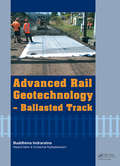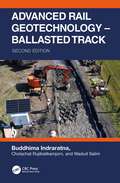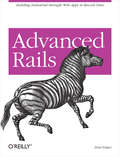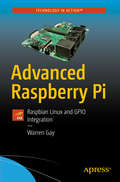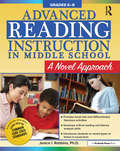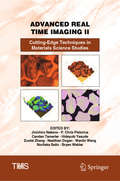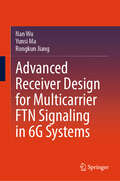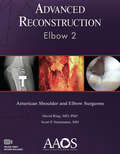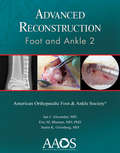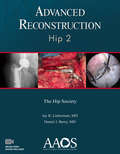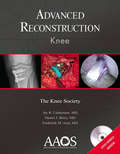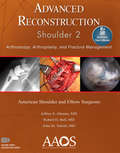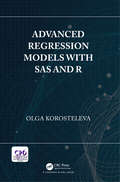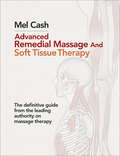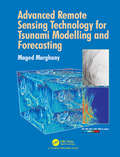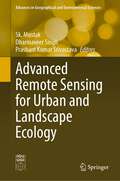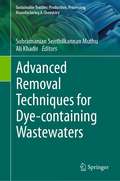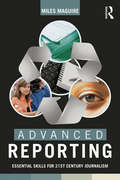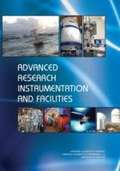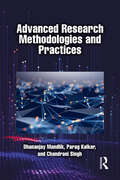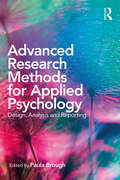- Table View
- List View
Advanced Rail Geotechnology - Ballasted Track
by Buddhima Indraratna Wadud Salim Cholachat RujikiatkamjornBallast plays a vital role in transmitting and distributing train wheel loads to the underlying sub-ballast and subgrade. Bearing capacity of track, train speed, riding quality and passenger comfort all depend on the stability of ballast through mechanical interlocking of particles. Ballast attrition and breakage occur progressively under heavy cyc
Advanced Rail Geotechnology – Ballasted Track
by Buddhima Indraratna Wadud Salim Cholachat RujikiatkamjornBallast plays a vital role in transmitting and distributing the train wheel loads to the underlying track substructure. The load-bearing capacity, safe train speed, and the levels of noise and vibration, as well as passenger comfort depend on the behaviour of ballast through particle interlocking and the corresponding deformation of this granular assembly. Attrition and breakage of ballast occur progressively under heavy and continual cyclic loading, causing track deterioration and rail misalignment affecting safety, while exacerbating the intensity of track maintenance. In the absence of realistic computational models, the track substructure is traditionally designed using mostly empirical approaches. In this book, the authors present the detailed information on the strength, deformation, and degradation aspects of fresh and recycled ballast under monotonic, cyclic, and impact loading using innovative geotechnical testing devices. A constitutive model for ballast incorporating particle breakage is presented representing a more realistic stress–strain response. The mathematical formulations and numerical models are validated using controlled experimental simulations and fully instrumented field trials. Revised ballast gradation is described to provide greater track resiliency and extended longevity. The book also provides a detailed description of geosynthetics for substructure improvement considering track deterioration caused by particle degradation, fouling, and impeded drainage. New to this second edition are extensive discussions on subgrade soil stabilisation, causes and mechanisms of soil fluidisation (mud pumping) under cyclic loading, and preventive and remedial measures to alleviate undue instability of ballast tracks. This book should prove most beneficial for final-year civil engineering students and for postgraduate teaching and learning. It is an ideal supplement for practising railway engineers and researchers engaged in the challenging tasks of future track design for heavier and faster trains.
Advanced Rails
by Brad EdigerReady to go to the next level with Rails? From examining the parts of Ruby that make this framework possible to deploying large Rails applications, Advanced Rails offers you an in-depth look at techniques for dealing with databases, security, performance, web services and much more. Chapters in this book help you understand not only the tricks and techniques used within the Rails framework itself, but also how make use of ideas borrowed from other programming paradigms. Advanced Rails pays particular attention to building applications that scale -- whether "scale" means handling more users, or working with a bigger and more complex database. You'll find plenty of examples and code samples that explain: * Aspects of Ruby that are often confusing or misunderstood * Metaprogramming * How to develop Rails plug-ins * Different database management systems * Advanced database features, including triggers, rules, and stored procedures * How to connect to multiple databases * When to use the Active Support library for generic, reusable functions * Security principles for web application design, and security issues endemic to the Web * When and when not to optimize performance * Why version control and issue tracking systems are essential to any large or long-lived Rails project Advanced Rails also gives you a look at REST for developing web services, ways to incorporate and extend Rails, how to use internationalization, and many other topics. If you're just starting out with rails, or merely experimenting with the framework, this book is not for you. But if you want to improve your skills with Rails through advanced techniques, this book is essential.
Advanced Rails: Building Industrial-Strength Web Apps in Record Time
by Brad EdigerReady to go to the next level with Rails? From examining the parts of Ruby that make this framework possible to deploying large Rails applications, Advanced Rails offers you an in-depth look at techniques for dealing with databases, security, performance, web services and much more.Chapters in this book help you understand not only the tricks and techniques used within the Rails framework itself, but also how to make use of ideas borrowed from other programming paradigms. Advanced Rails pays particular attention to building applications that scale -- whether "scale" means handling more users, or working with a bigger and more complex database. You'll find plenty of examples and code samples that explain:Aspects of Ruby that are often confusing or misunderstoodMetaprogrammingHow to develop Rails plug-insDifferent database management systemsAdvanced database features, including triggers, rules, and stored proceduresHow to connect to multiple databasesWhen to use the Active Support library for generic, reusable functionsSecurity principles for web application design, and security issues endemic to the WebWhen and when not to optimize performanceWhy version control and issue tracking systems are essential to any large or long-lived Rails projectAdvanced Rails also gives you a look at REST for developing web services, ways to incorporate and extend Rails, how to use internationalization, and many other topics. If you're just starting out with rails, or merely experimenting with the framework, this book is not for you. But if you want to improve your skills with Rails through advanced techniques, this book is essential.
Advanced Raspberry Pi: Raspbian Linux And Gpio Integration
by Warren GayJump right into the pro-level guts of the Raspberry Pi with complete schematics and detailed hardware explanations as your guide. You'll tinker with runlevels, reporting voltages and temperatures, and work on a variety of project examples that you can tune for your own project ideas.. This book is fully updated for the latest Pi boards with three chapters dedicated to GPIO to help you master key aspects of the Raspberry Pi. You'll work with Linux driver information and explore the different Raspberry Pi models, including the Pi Zero, Pi Zero W, Pi 2, Pi3 B and Pi3 B+. You'll also review a variety of project examples that you can tune for your own project ideas. Other topics covered include the 1-Wire driver interface, how to configure a serial Linux console, and cross-compile code, including the Linux kernel. You'll find yourself turning to Advanced Raspberry Pi over and over again for both inspiration and reference. Whether you're an electronics professional, an entrepreneurial maker, or just looking for more detailed information on the Raspberry Pi, this is exactly the book for you.What You'll LearnMaster I2C and SPI communications from Raspbian Linux in CProgram USB peripherals, such as a 5-inch LCD panel with touch control and the Pi cameraStudy GPIO hardware, the sysfs driver interface and direct access from C programsUse and program the UART serial device. Who This Book Is ForAdvanced Raspberry Pi users who have experience doing basic projects and want to take their projects further.
Advanced Reading Instruction in Middle School: A Novel Approach (Grades 6-8)
by Janice I. RobbinsAddressing the needs of academically advanced young adolescents in reading is a tall order. Advanced Reading Instruction in Middle School offers teachers a structured process for guiding students in preparing for collaborative discussions about books. Structured discussions enable students to examine the author's work together as they respond to essential questions, using evidence from the reading. Students are directed to make personal connections to story characters, plots, and settings. They are asked to explore the writer's craft through the examination of selected words, structures, settings, and literary devices incorporated in the novels. This guide includes specific literary analysis activities suitable for the six types of fiction presented and offers annotated lists of recommended advanced-level books of each type, including those recommended in the CCSS. The guide also supports the social and emotional issues of early adolescents, offering specific works suitable for a range of common topics such as identity, friendships, high expectations, and feelings of isolation.Grades 6-8
Advanced Real Time Imaging II: Cutting-Edge Techniques in Materials Science Studies (The Minerals, Metals & Materials Series)
by Jinichiro Nakano P Chris Pistorius Candan Tamerler Hideyuki Yasuda Zuotai Zhang Neslihan Dogan Wanlin Wang Noritaka Saito Bryan Webler“Real time” imaging techniques have assisted materials science studies especially for non-ambient environments. These techniques have never been collectively featured in a single venue. The book is an assembly of materials studies utilizing cutting edge real time imaging techniques, emphasizing the significance and impact of those techniques.
Advanced Receiver Design for Multicarrier FTN Signaling in 6G Systems
by Nan Wu Yunsi Ma Rongkun JiangThis book focuses on the design of low-complexity iterative receivers in high spectral efficiency communication systems, especially under frequency-selective fading channels. Specifically, it combines multi-carrier faster-than-Nyquist (MFTN) signaling, spectrally efficient frequency division multiplexing (SEFDM), and index modulation (IM) to study the hybrid message passing based low-complexity iterative receivers, the frequency-domain joint channel estimation and equalization (FDJCEE) algorithm, and the vector approximate message passing (VAMP) based iterative equalization algorithms. These methods effectively address the challenges of symbol detection and channel estimation for MFTN signaling and significantly improve the spectral efficiency and bit error rate (BER) performance. This book is of a good reference for researchers, engineers, and students in the fields of wireless communications and signal processing.
Advanced Reconstruction: Elbow 2 (Advanced Reconstruction Ser.)
by David Ring Scott P. SteinmannGet expert insight and practical guidance to master the latest techniques in elbow surgery. More than 35 leading surgeons provide technical guidance through 30+ surgical challenges. This title was developed in collaboration with the American Shoulder and Elbow Surgeons.
Advanced Reconstruction: Foot And Ankle 2 Ebook (Advanced Reconstruction Ser.)
by Ian J. AlexanderConfer with leading surgeons on the most effective way to solve complex surgical problems. 110+ pioneering surgeons share tips, pearls, and strategies Step-by-step guidance for 65+ challenging techniques 600+ illustrations demonstrate crucial details
Advanced Reconstruction: Hip 2
by Daniel J. Berry Jay R. LeibermanExpert insight and practical guidance help you master every technique and make the best decisions for each patient.
Advanced Reconstruction: Knee (Advanced Reconstruction Ser.)
by Frederick Azar Daniel J. Berry Jay R. LiebermanThe world's leading knee reconstruction and sports medicine surgeons guide you to manage the toughest cases you'll see. Step-by-step guidance for more than 70 advanced reconstruction techniques.
Advanced Reconstruction: Shoulder 2
by Robert H. Bell Jeffrey S. Abrams John M. TokishGet expert insight and practical guidance to master the latest techniques, including minimally invasive techniques for instability, rotator cuff pathology, and arthritis. Now in a case-based format: each author describes the case, addresses alternative approaches and controversies, and offers evidence and experience to support the recommended approach.
Advanced Redox Flow Technology
by Inamuddin Tariq AltalhiADVANCED REDOX FLOW TECHNOLOGY This book serves as a comprehensive guide to redox flow technologies, from their basic principles to their applications. As a result, this book provides a thorough review of craftsmanship in the subject, as well as the potential for future advances. As energy becomes a greater global concern, redox flow technology must be considered as a possibility. There is concern over energy shortages and rising air pollution, paving the way for renewable energies like solar and wind energy which have been extensively analyzed and evaluated in recent years. These renewable sources, on the other hand, are intermittent and frequently unpredictably available, resulting in low-quality output energy and a negative influence on grid stability. To date, diverse types of energy storage systems have been designed for various purposes, each with its own set of benefits and drawbacks. In recent years, redox flow technology, particularly vanadium redox flow, has progressed substantially. Experiments at various scales have been successfully carried out, proving the viability of redox flow technology in bulk energy storage applications. In addition, innovative redox flow technologies that offer more energy storage per unit mass or a more cost-effective volume of the storage device have attracted a lot of interest. This book is intended to serve as a comprehensive guide to redox flow technologies, from their basic principles to their applications. As a result, this book provides a thorough review of the craftsmanship in the subject, as well as the potential for future advances. Advanced redox flow technology has sparked interest in bulk energy storage due to its flexibility in design, safety in operation, efficient energy storage, and near-zero environmental impact. The technology has been extensively developed and tested at a range of levels in recent years, demonstrating its applicability and usage.
Advanced Regression Models with SAS and R
by Olga KorostelevaAdvanced Regression Models with SAS and R exposes the reader to the modern world of regression analysis. The material covered by this book consists of regression models that go beyond linear regression, including models for right-skewed, categorical and hierarchical observations. The book presents the theory as well as fully worked-out numerical examples with complete SAS and R codes for each regression. The emphasis is on model accuracy and the interpretation of results. For each regression, the fitted model is presented along with interpretation of estimated regression coefficients and prediction of response for given values of predictors. Features: Presents the theoretical framework for each regression. Discusses data that are categorical, count, proportions, right-skewed, longitudinal and hierarchical. Uses examples based on real-life consulting projects. Provides complete SAS and R codes for each example. Includes several exercises for every regression. Advanced Regression Models with SAS and R is designed as a text for an upper division undergraduate or a graduate course in regression analysis. Prior exposure to the two software packages is desired but not required. The Author:Olga Korosteleva is a Professor of Statistics at California State University, Long Beach. She teaches a large variety of statistical courses to undergraduate and master’s students. She has published three statistical textbooks. For a number of years, she has held the position of faculty director of the statistical consulting group. Her research interests lie mostly in applications of statistical methodology through collaboration with her clients in health sciences, nursing, kinesiology, and other fields.
Advanced Remedial Massage
by Mel CashRemedial massage therapy uses manual therapy techniques to treat and 'remedy' a problem; but to offer a real remedy you must do more than just relieve pain; you must also understand how the problem came about and how it can be avoided in future. Advanced Remedial Massage places the emphasis on remedial therapy as well as massage, and will appeal to students of physiotherapy, oestotherapy and many other manual therapies. The book takes the reader through the practice of remedial massage, the effects and benefits that arise from it, a guide to the human muscular system, basic massage techniques and more detailed treatment practices. Illustrated with more than 200 full-colour photographs and over 50 diagrams, the techniques are easy to follow and understand. This informative guide is a must-have both for students of remedial massage and for professional therapists.
Advanced Remote Sensing Technology for Covid-19 Monitoring and Forecasting
by Maged MarghanyThis book provides a groundbreaking exploration of satellite remote sensing's role in tracking the mobility and spread of COVID-19, focusing on its origin in Wuhan City. It addresses the gap in research by employing advanced techniques like quantum image processing to analyze satellite data and differentiate between COVID-19-related deaths and other causes. Additionally, it explores conspiracy theories, vaccine development through quantum mechanics, and the use of quantum computing for detecting pandemic patterns. The book also delves into the economic impact of COVID-19, offering a scientific response to geopolitical tensions and media accusations surrounding the pandemic's origins.
Advanced Remote Sensing Technology for Tsunami Modelling and Forecasting
by Maged MarghanyThe innovation in space technologies has generated a new method for observing and monitoring tsunamis from space. Most tsunami remote sensing studies focus on using classical image processing tools or conventional edge detection procedures. However, these methods do not use modern physics, applied mathematics, signal communication, remote sensing data and innovative space technologies. This book equips readers to understand how to monitor tsunamis from space with remote sensing technology art to create a better alarm warning system.
Advanced Remote Sensing for Urban and Landscape Ecology (Advances in Geographical and Environmental Sciences)
by Dharmaveer Singh Sk. Mustak Prashant Kumar SrivastavaThis book introduces the use of various remote sensing data such as microwave, hyperspectral and very high-resolution (VHR) satellite imagery; mapping techniques including pixel and object-based machine learning; and geostatistical modelling techniques including cellular automation, entropy and land fragmentation. Remote sensing plays a vital role in solving urban and environmental challenges at the landscape level. Globally, more than half of the urban population is facing severe environmental and social challenges, especially those relating to climate change, agricultural land encroachment, green infrastructure and environmental degradation, mobility due to rapid rural–urban transformation and anthropogenic interventions. Mapping and quantification of such threats at the landscape level are challenging for experts using traditional techniques; however, remote sensing technology provides diverse spatial data at a varying scale, volume and accessibility for mapping and modelling, and it also analyses challenges at urban and landscape levels. Together, they address challenges at urban and landscape levels to support the Sustainable Development Goals (SDGs).
Advanced Removal Techniques for Dye-containing Wastewaters (Sustainable Textiles: Production, Processing, Manufacturing & Chemistry)
by Subramanian Senthilkannan Muthu Ali KhadirThe book presents a sequential approach for the treatment of dye wastewater, presenting state-of-the-art techniques based on recent findings. The release of these dyes into the environment is a major threat due to their toxicity, mutagenicity and carcinogenicity and their biotransformation products. It has been at least two decades since researchers have been trying to find interactions between dye molecules and water media, and find new purification methods. This book plays an important role in this field by highlighting the cutting edge results in dye removal and remediation, and discusses in detail the application of various physical, chemical, and biological techniques for the removal of pollutants from water.
Advanced Reporting: Essential Skills for 21st Century Journalism
by Miles MaguireNews gathering is a large, complicated and often messy task that has traditionally been viewed by journalists as irretrievably idiosyncratic, best learned through trial and error. Advanced Reporting takes the opposite approach, focusing on reporting as a process of triangulation based on three essential activities: analyzing documents, making observations and conducting interviews. In this readable book, veteran journalism professor Miles Maguire shows how the best reporters use these three tools in a way that allows them to cross-check and authenticate facts, to reduce or eliminate unsupportable allegations and to take readers and viewers to a deeper level of insight and understanding. This book will help to prepare students for a profession marked by increasing complexity and competition. To succeed in this environment, journalists must learn to make the most of digital media to intensify the impact of their work. At the same time, reporters must contend with a host of sophisticated public relations techniques while engaging with news audiences that no longer just consume journalism, but also collaborate in its creation. Discussion questions and exercises help students put theory into practice.
Advanced Research Instrumentation And Facilities
by National Academy Of Sciences National Academy of Engineering Institute of Medicine of the National AcademiesIn recent years, the instrumentation needs of the nation’s research communities have changed and expanded. The need for particular instruments has become broader, crossing scientific and engineering disciplines. The growth of interdisciplinary research that focuses on problems defined outside the boundaries of individual disciplines demands more instrumentation. Instruments that were once of interest only to specialists are now required by a wide array of scientists to solve critical research problems. The need for entirely new types of instruments—such as distributed networks, cybertools, and sensor arrays—is increasing. Researchers are increasingly dependent on advanced instruments that require highly specialized knowledge and training for their proper operation and use. The National Academies Committee on Science, Engineering, and Public Policy Committee on Advanced Research Instrumentation was asked to describe the current programs and policies of the major federal research agencies for advanced research instrumentation, the current status of advanced mid-sized research instrumentation on university campuses, and the challenges faced by each. The committee was then asked to evaluate the utility of existing federal programs and to determine the need for and, if applicable, the potential components of an interagency program for advanced research instrumentation.
Advanced Research Methodologies and Practices
by Chandrani Singh Dhananjay Mandlik Parag KalkarThis comprehensive textbook is designed to equip researchers, academics, and students with the essential tools and knowledge needed to conduct advanced research across various disciplines.The book addresses crucial aspects of research dissemination and publication, offering insights into scholarly writing, manuscript preparation, and the peer review process, empowering researchers to effectively communicate their findings and contribute to their respective fields. It covers salient topics such as formulating research questions, designing research studies, and selecting appropriate research methodologies. It emphasizes the importance of rigorous and ethical research practices and explores strategies for conducting literature reviews and synthesizing existing knowledge. It also delves into advanced quantitative and qualitative research methods, offering detailed explanations of statistical analyses, data collection techniques, and sampling strategies.Throughout the book, real-world examples, case studies, and practical exercises are integrated to enhance understanding and application of the concepts discussed to equip the readers with the knowledge, skills, and confidence to push the boundaries of knowledge and make a lasting impact. It will serve as an invaluable resource for students, researchers, academics, and industry professionals seeking to enhance their research skills and elevate the quality and impact of their scholarly work.
Advanced Research Methods for Applied Psychology: Design, Analysis and Reporting
by Paula BroughThis is the first comprehensive guide to the range of research methods available to applied psychologists. Ideally suited to students and researchers alike, and covering both quantitative and qualitative techniques, the book takes readers on a journey from research design to final reporting. The book is divided into four sections, with chapters written by leading international researchers working in a range of applied settings: Getting Started Data Collection Data Analysis Research Dissemination With coverage of sampling and ethical issues, and chapters on everything from experimental and quasi-experimental designs to longitudinal data collection and focus groups, the book provides a concise overview not only of the options available for applied research, but also of how to make sense of the data produced. It includes chapters on organizational interventions and the use of digital technologies, and concludes with chapters on how to publish your research, whether it’s a thesis, journal article or organisational report. This is a must-have book for anyone conducting psychological research in an applied setting.
Advanced Research Methods for Applied Psychology: Design, Analysis and Reporting
by Paula BroughAdvanced Research Methods for Applied Psychology provides a comprehensive discussion of 21 key topics for the completion of an applied psychology (or similar) research thesis/project.The book provides a one-stop shop for the current issues and discussions of key research methods and common statistical analysis techniques, but avoids being a step-by-step instruction guide. The book is divided into four sections, representing the stages of thesis completion: getting started, data collection, data analysis, and reporting research. Each chapter presents a detailed scholarly discussion on a topic and represents the most up-to-date reference for that topic. The Chapters also provide key references for further detailed readings and guides. The chapters are authored by leading researchers from all around the world. This book discusses both emerging and traditional research methods commonly utilised within applied psychology research projects and directly assists early researchers in providing an informed discussion of their decisions relating to their choice of, for example, research sampling, the use of diary studies, appropriate survey time-lags, conducting systematic reviews, and the macro and micro process issues involved with conducting organisational interventions.This book is an important reference text for applied psychology research thesis/project students and researchers, including both undergraduate and postgraduate students. It will be of interest to applied psychology researchers in all fields (clinical, organisational, developmental, forensic, etc.) and to those in other disciplines. The book provides coverage of advanced research methods and statistical topics and is suitable for adoption for these courses in honours/post-graduate levels of study within applied psychology and related fields.
